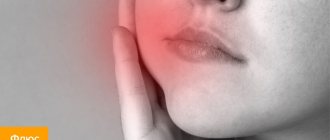Toothache has its own properties and characteristics. Based on how exactly the tooth hurts, the dentist can make a diagnosis and carry out treatment. For example, acute sudden pain radiating to the jaw or temple most often indicates inflammation of the nerve of the tooth - pulpitis. Aching periodic pains that subside on their own indicate a chronic process, possibly periodontitis, etc.
Tooth sensitivity when pressed can be caused by several diseases.
— 15% on the first visit
Main reasons
Pain is a kind of “alarm” from the body, drawing attention to malfunctions in its functioning. The oral cavity is no exception: if a seemingly healthy tooth hurts when pressed, this indicates that something has happened to it. As a rule, the reason is damage to the crown, root, gums, or the presence of an inflammatory process. But provoking factors can be very diverse: injuries, infections, insufficient hygiene and even medical errors. Let's look at each case in more detail.
The tooth hurts when you press on it: after depulpation (nerve removal)
The pulp is nerve fibers and vessels that provide sensitivity and nutrition to the tooth. After their removal, the tooth is considered dead, and it may seem that this is the solution to any problem, because a dead tooth is unlikely to hurt. This is wrong. A pulpless tooth can be disturbing for several reasons:
- if the dentist, while cleaning the canals, punctured the root;
- when the thin end of the endoscopic instrument breaks off and remains inside the canal;
- in case the dental canals have not been completely cleaned and an infection remains in them.
In the first two cases, the pain is quite sharp: the pulpless tooth hurts not only when pressed, but even when touched lightly. If the dentist cleans the canals poorly, pain appears after some time. In any case, a tooth without a nerve that causes discomfort is a reason for a repeat visit to the dental office.
Periodontitis
Sometimes painful sensations occur in a tooth from which the nerve has already been removed. When pressed, the tooth hurts and aches. Many patients are perplexed as to how a fully treated organ can produce such symptoms. However, treatment is not always of high quality. The following mistakes may be made during canal filling:
- perforation of root canal tissues with an endodontic tip;
- incomplete cleansing of nerve tissue from the canal;
- poor quality disinfection of treated canals;
- insufficient tightness of canal sealing;
- the use of cheap fillings that can dry out over time.
All of the above reasons lead to various complications in the dental cavity. Of course, this does not happen immediately after treatment: it may take a month, and sometimes several years. However, such therapy will sooner or later make itself felt. The causing tooth will begin to ache at night, and then will react with pain to any pressure. The essence of periodontitis is the penetration of infection into the tissues of the dentoligamentous apparatus. Through the tip of the root canal, pathogenic bacteria enter the periodontium. There they slowly spread, forming cysts and granulomas of various types. Treating this type of inflammation is quite difficult and takes a long time, and a large percentage of such diseases require removal of the neglected organ.
When the first symptoms of periodontitis appear, dentists recommend following the following tips:
- If a tooth hurts when biting, it is strictly forbidden to apply heat to the sore spot;
- take one or two tablets of painkillers such as paracetamol, tempalgin, analgin;
- brush your teeth, removing food debris from the carious cavity of the affected tooth;
- rinse your mouth several times a day with a solution of potassium permanganate, soda or furatsilin;
- Do not take anti-inflammatory drugs or antibiotics without a doctor’s prescription.
In order to prevent unpleasant consequences for the health of the body, treatment of periodontitis should not be postponed and hope that the disease will disappear over time. A timely visit to the dentist will preserve not only the health of the tooth, but also the entire body, since periodontitis contributes to the emergence and spread of harmful substances. Of course, toxins will negatively affect the functioning of internal organs and a person’s well-being.
The LeaderStom network of clinics specializes in dental therapy, orthodontics and prosthetics. Our specialists try to cure even the most advanced cases of chronic pulpitis and periodontitis with maximum preservation of natural dental tissues. Treatment tactics depend on the degree of neglect. In the initial stages, the disease can be eliminated by refilling the canals. By eliminating the source of infection, dentists achieve stable remission of the tooth and restoration of periodontal tissue. If the inflammation process has covered a large area of tissue, and a purulent process has already formed near the apex of the root, then in this case either surgical intervention or removal of the diseased tooth is possible.
Tooth hurts when pressed after filling
Slight pain after the doctor has given a filling to the patient is normal: during the sanitization of cavities affected by caries, the tissues receive microtrauma. The condition is easily treated with analgesics and goes away on its own in 2-3 days. But if a filled tooth hurts when pressed hard enough, then the problem is one of five reasons:
- high filling - the occlusion is disrupted, the tooth experiences excessive pressure and becomes painful;
- the dental pulp was burned when the filling was treated with a photopolymer lamp;
- a gap has appeared between the filling and the enamel, into which bacteria and food particles have entered, causing inflammation;
- the cavities affected by caries were not drilled out thoroughly enough, and it reappeared;
- I developed an allergy to the filling.
If the tooth under the filling hurts when pressed, this means that you need to make an appointment with the doctor again and have it filled again.
The first group includes:
Caries
A carious cavity is a depression in the hard tissues of the tooth that appears as a result of their destruction. Food or drinks (most often cold) enter the cavity and cause short-term (several seconds) pain. If food is retained in the carious cavity (especially sweet food), the pain may last longer.
Seal defect
If part of the filling (or part of the hard tooth tissue around the filling) placed previously breaks off under the influence of chewing load, a part of the tooth that is more sensitive to the effects of food is exposed.
Chronic apical periodontitis in the acute stage
It sounds scary...and in reality it is no less terrible. The mechanism of pain in this case is quite simple. Around the apex of the root, surrounded by a dense bone plate, the inflammatory process is activated. Inflammation in all parts of our body proceeds along approximately the same path and is characterized by an increase in the volume of inflamed tissue (due to blood flow to the affected area). And if this happens, for example, when a hand is bruised, then we will see swelling, that is, an increase in volume. Now let’s imagine the formation of a “swelling” in the area of the root apex surrounded by a dense bone plate... there is no room for the incoming fluid, the nerve endings are compressed, and here you are also trying to chew a delicious steak!
Periodontitis
One of the causes of tooth pain is periodontitis.
The thing is very unpleasant (like most dental diseases). It is characterized by a long-term, most often sluggish inflammatory process of all tissues surrounding the tooth (gums, ligaments, bone surrounding the tooth), leading to their atrophy (reduction). As a result, the tooth becomes mobile and cannot withstand the chewing load, which is indicated by pain.
Functional overload
Each of our teeth, depending on the function it performs, is designed for certain chewing loads. However, if for some reason the number of teeth decreases (extraction, injury, etc.), the remaining ones begin to experience increased chewing pressure (for themselves and for the lost ones). Such excessive load leads to loosening of the tooth and the appearance of the symptom we are discussing. Only high-quality prosthetics will help solve this problem.
Injury to the gingival papilla by hard food
The reasons for this phenomenon may be:
Large distances between teeth (diastema and trema). They can be either physiological in nature (features of the anatomical structure) or pathological (for example, “divergence” of teeth during periodontitis);
Poorly restored contact point
A contact point is a point or area through which adjacent teeth contact each other and through which chewing pressure is distributed. If the carious cavity was located on the side surface of the tooth and after filling it, the contact point was not properly restored, then food will get clogged between the teeth when chewing, injuring the gingival papilla. Hence the pain. This reason relates more to the second group, so let’s move on to it.
The treated tooth hurts when pressed after canal filling
Working with roots requires precision and accuracy from the doctor. If he incorrectly assessed the depth of the canals, then the following complications cannot be excluded:
- a tooth without a nerve hurts when pressed if the filling material extends beyond the apex of the root, gets into the gum and puts pressure on it;
- when the channels, on the contrary, are not completely filled, inflammation may begin in the voids over time. If a lot of time has passed after visiting the doctor, and the tooth aches and hurts, then the problem is the unsatisfactory filling of the canals.
The tooth under the crown hurts when pressed
Crowns and bridges can also cause many unpleasant moments for their owner. Normally, you may feel discomfort under the crown for several days after installation, but as you adapt, the pain gradually goes away. If a month later the tooth still aches a lot and hurts when pressed, and also if the pain under the crown appears suddenly, this is a reason to consult a doctor.
There are four main reasons:
- the crown became loose, food particles and plaque accumulated under it, and inflammation began;
- the crown is cracked or split;
- the tooth is poorly ground under the crown;
- The shape of the crown is chosen incorrectly; it puts pressure on neighboring teeth or gums.
A healthy tooth hurts when pressed
What should you do if, when pressed, a tooth that has not been sanitized, depulped, drilled or loaded with a crown hurts? Yes, this happens too. Here are a few reasons why a seemingly healthy tooth can be painful.
- Periodontitis. This is an inflammatory disease of the tissues around the teeth. When pressed, both the gums and the tooth hurt at the same time. If no action is taken, progressive periodontitis will lead to a reduction in the volume of the gums and even bone, and then the tooth will become loose and may fall out.
- Excessive enamel sensitivity. It is provoked by chemical teeth whitening, after which even a tooth with a nerve can ache when biting or drinking cold and hot drinks. Teeth with filled canals do not have this problem. You can make your enamel less sensitive at home by using remineralizing gels and toothpastes.
- Removal of a tooth. After surgery, the adjacent healthy tooth may hurt. This is due to damage to soft tissues and does not require any additional therapy other than that prescribed by the doctor.
Toothache after filling
4422 March 25
IMPORTANT!
The information in this section cannot be used for self-diagnosis and self-treatment.
In case of pain or other exacerbation of the disease, diagnostic tests should be prescribed only by the attending physician. To make a diagnosis and properly prescribe treatment, you should contact your doctor. Toothache: causes of occurrence, what diseases it occurs with, diagnosis and treatment methods.
Definition
After filling a cavity or canal of a tooth, pressing or bursting pain may occur. Sometimes pain occurs when biting, chewing and tapping a tooth; in some cases, the pain becomes acute with the development of swelling of the gums in the area of the causative tooth.
Types of toothache after filling
Depending on the cause of the appearance, local or diffuse toothache after filling is distinguished. More often it is transient and goes away on its own after a short time (no more than a day).
In some patients, after filling a carious cavity with deep caries or a canal with pulpitis, the intensity of pain gradually increases, it can be paroxysmal in nature, intensify under the influence of cold, and radiate along the branches of the trigeminal nerve. If left untreated, such pain becomes throbbing, the tooth may react to hot food, and swelling and redness of the gums develop. An infiltrate may form on the gum, from which pus or an abscess flows out when opened.
Possible causes of toothache after filling
Impact of irritants on the pulp.
First of all, you need to understand the location, intensity of pain and under what circumstances it occurs. If pain appears immediately after installation of a filling, this may be a consequence of the reaction of the nerves of the tooth and periapical tissues (tissues surrounding the root of the tooth) to mechanical, thermal and chemical influences.
Pain after the cessation of anesthesia indicates restoration of tissue sensitivity. As a rule, discomfort disappears within 24 hours after treatment.
Sometimes strong drugs placed into the tooth cavity lead to overdrying of dentin (the main solid substance of the tooth surrounding the pulp) and even to chemical burns of the pulp. This complication is accompanied by an acute pain reaction to cold and hot foods and sweets.
Incorrect installation of the seal
. If the upper border of the filling protrudes above the chewing surface of the tooth, then all the pressure of the opposite jaw during chewing falls on one tooth. This leads to overload of the ligamentous apparatus of the tooth, injury to the periapical tissues and the occurrence of dull local pain during chewing. To prevent such a complication, the doctor, after installing the filling, conducts a test with carbon paper. The paper is placed on the tooth with a filling and the patient is asked to close the jaws and make lateral and anteroposterior movements. The cusps of the tooth, which are marked with carbon paper, are ground off.
It is a mistake to think that excess filling material will wear off on its own over time.
The process of natural grinding lasts for years, during which time the patient experiences pain when chewing and, ultimately, this leads to traumatic periodontitis (inflammation of the tissues surrounding the tooth). Inflammation of the periapical tissues
and the appearance of pain may be a consequence of pushing the filling material beyond the apex of the root canal. Together with the filling mass, infected tissues from the tooth canal enter the periodontium, which cause periodontitis. In this case, prolonged aching pain occurs, which intensifies when pressing on the diseased tooth. Tapping on a tooth is painful. Nearby lymph nodes (for example, submandibular) may enlarge. There is a risk of accumulation of purulent exudate in the area of the root apex and the formation of an abscess. The gums near the diseased tooth swell and turn red. Sometimes pus breaks through the gum, in these cases the swelling, redness and pain decrease. However, without treatment, this process constantly recurs.
Pain after filling can also occur in cases where one of the canals extending from the pulp chamber remains untraversed.
The number and location of canals in multi-rooted teeth varies from person to person.
If during tooth sanitation one of the canals remains unnoticed, the infection from it penetrates into the periodontium with the development of chronic periodontitis.
Close location of the carious cavity to the dental pulp
. In some cases, the bottom of the cavity is located too close to the pulp. The thin intermediate layer of dentin is penetrated by short tubes, through which infection from the carious cavity can enter the pulp and cause its inflammation (pulpitis). In these cases, hyperemia of the pulp develops (the initial stage of pulpitis), which, if left untreated, turns into acute pulpitis. There is no pain when tapping on the causative tooth.
A characteristic sign of initial pulpitis is pain that occurs upon contact with irritants (temperature and chemical) and goes away a few minutes after the cessation of their influence.
In other cases, the doctor may not recognize the initial stage of pulpitis when filling a tooth. In this case, sealing the infected pulp leads to acute pulpitis, which is accompanied by sharp, paroxysmal pain, intensifying at night and radiating along the branches of the trigeminal nerve.
Which doctors should I contact for toothache after filling?
If pain occurs immediately after dental treatment, you should contact your dentist. However, in some cases, when there are no signs of malocclusion and periodontitis and pulpitis are not observed on radiographs, the patient may be referred for consultation to an otolaryngologist (if sinusitis is suspected) or (if inflammation of the trigeminal nerve is suspected).
Diagnosis and examination for toothache after filling
The connection between the occurrence of pain and previous dental treatment helps to make a preliminary diagnosis. The presence of an inflammatory process is confirmed by redness and swelling of the gums.
However, accurate diagnosis is only possible after radiography.
In the absence of clear radiological signs of periodontitis, they resort to electroodontodiagnostics (a method for assessing the condition of the pulp, in which its reaction to a weak electric current is checked), it allows one to assess the degree of damage to the pulp.
What to do if you have toothache after filling
Mild, aching pain after tooth treatment may continue for 1-2 days, and this is normal.
However, if the pain does not subside or intensifies, a consultation with a dentist is necessary to diagnose possible complications.
Treatment of toothache after filling
If the pain is caused by malocclusion due to excess filling material, it should be sanded off.
Pain due to the development of pulpitis requires opening the pulp chamber and depulping the tooth. Acute and chronic periodontitis also indicates the need for unfilling of root canals and their mechanical and medicinal treatment. After treating the cavity and canals, the doctor can apply therapeutic and insulating linings, covering the tooth with a temporary filling, then another visit will be required so that the doctor can re-treat the cavity and place a permanent filling.
Sources:
- Clinical recommendations (treatment protocols) for the diagnosis of periapical tissue disease // Moscow State Medical and Dental University named after. A.I. Evdokimov of the Ministry of Health of the Russian Federation. – 2014.
- Therapeutic dentistry: Textbook / ed. Borovsky E.V. – M.: Medical Information Agency. 2004. - 400 p.
IMPORTANT!
The information in this section cannot be used for self-diagnosis and self-treatment. In case of pain or other exacerbation of the disease, diagnostic tests should be prescribed only by the attending physician. To make a diagnosis and properly prescribe treatment, you should contact your doctor.
What should you do if your tooth hurts when you press it?
Pain almost always accompanies the rehabilitation period after dental surgery. If the patient follows the doctor’s recommendations, the discomfort disappears on its own after 2-4 days, however, in some cases, pain can signal complications. The patient should return for a follow-up appointment if:
- immediately after the anesthesia wears off, severe and sharp pain appears;
- More than a week has passed after treatment, but the toothache does not go away;
- The rehabilitation period went well, but after 1-3 months pain appeared again.
The most important thing is not to endure, but to figure out where the pain comes from.
Ways to treat and reduce tooth pain when chewing
If you experience pain while chewing food, you should immediately seek help, without waiting for the pain to go away on its own or for additional unpleasant symptoms to appear, such as temperature and swelling, which indicate the presence of a significant inflammatory process in the body. However, if it is not possible to go to the dentist in the near future, you can independently relieve the pain and stop the development of inflammation with the help of a few simple procedures.
Ways to reduce pain when chewing:
- rinse the mouth with herbal tinctures or soda solution;
- make tooth lotions from mint, cloves or sea buckthorn oil;
- After each meal, use dental floss and rinse your mouth to get rid of food debris;
- to disinfect the oral cavity, keep onion peel tincture in your mouth for 20 minutes;
- for acute pain, you can take a painkiller, for example spasmolgon, analgin, nurofen, etc.
These methods will help reduce pain before visiting a doctor. However, it is impossible to cure the cause of toothache with their help, so it is necessary to seek qualified help as soon as possible in order not to aggravate the situation and prevent the development of other oral diseases.










